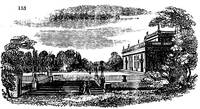483. The palace of Lazienki (figs. 152. and 153.), a beautiful piece of Roman architecture, from the designs of Camsitzer, a German artist, is placed on an island in a considerable piece of water. It consists of a centre and two wings. The centre is placed in the middle of a narrow part of the lake, and the wings are on opposite shores, and joined to the centre by arches with orangeries over. The entrance is by a carriage-portico, in one of the wings, at which you arrive without seeing the lake; and on entering the orangery, its first effect is surprising and delightful. On the north shore of this lake is an open amphitheatre of stone with its orchestra on the brink of the water; and near the margin is an island of trees, which served as the proscenium. This theatre was at all tunes open to the public; and in addition to the ordinary exhibitions, ships and naval engagements were occasionally exhibited. The gaiety which reigned here during the first years of the reign of Stanislaus, the singular effect of the illuminations, the ships, and the resounding of the music in the woods, are still recollected by some of the oldest inhabitants of Warsaw, and spoken of with feelings of regret. The grounds were not extensive, nor, except near the palace, much ornamented: they consisted of a number of broad green alleys, crossing each other at right angles; of smaller covered paths, leading to open circles of turf for dancing and music, and for tents and booths on extraordinary occasions. In several places coffee-rooms and ice-cellars were established, and still remain; there were two pavilions for the king's mistresses; and another, which served as a seraglio, for strangers, or visitors of the king: the three being connected with the palace by arbour-like paths, or arcades of trellis-work, covered by creepers. One thing deserves to be remarked as to these gardens, which is, perhaps, not to be found in any others in Europe, pedestals, as if for placing statues, were ranged in different parts of the grounds, particularly along the broad walk leading from the palace to the amphitheatre. On these pedestals, on extraordinary occasions, selected living figures, male and female, dressed in character, were placed and taught to maintain certain attitudes, after the manner of the representations called Tableaux, and which are sometimes, though rarely, produced in private circles at Paris and Vienna, on days when theatrical amusements are forbidden. It is not to be wondered at that so luxurious a king should have wanted decision of character, lost his honour, kingdom, and, in short, every thing worth having. In 1813, this seat was nearly in the state in which it was left by Stanislaus; but we understand it has since undergone several changes.



